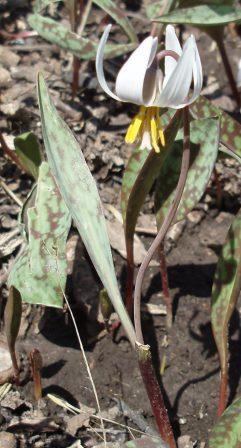by Carl Strang
One of my winter projects has been to study the herbaceous plants, so see how they might be identified in the snowy season. There have been many posts on that subject here over the past few winters. As I run down the list of species at Mayslake Forest Preserve, though, there are many I have not been able to find. Therefore I am trying to keep mindful of them this growing season, to follow their careers and see what becomes of them.
One group of plants in this category are the spring ephemerals, the woodland plants that send up shoots at the beginning of the growing season, bloom, set seeds, and finish as the forest canopy closes and light becomes greatly diminished at ground level. Some of the Mayslake species in this category are spring beauty, Dutchman’s breeches, cutleaf toothwort, and white trout lily.
The bottom line is that these plants withdraw to their roots and cut off their tops, which wither and are recycled by the efficient decomposers in the soil. This is true even of the trout lilies, whose leaves are thick and waxy.
This past week I looked, but failed to see any sign of the trout lilies where they had been so thick just a few weeks earlier. The same is true of the entire category of spring ephemerals. Here, then quickly gone…except that the roots or bulbs persist beneath the soil, patiently waiting for another year to pass.


theoutsideblog said,
June 19, 2013 at 11:35 pm
It’s absolutely amazing to me how large the difference between a woodland mid April and a woodland mid June and a woodland mid August can be.
natureinquiries said,
June 20, 2013 at 5:54 am
Agreed. And each season contains the seeds of the next. We see the preface of mid-summer now, and soon will come hints of late summer.
MJ - Oakmoss said,
June 21, 2013 at 9:53 am
I suspect that since the leaves serve no purpose once the canopy shades out the sun, in true conservation mode these plants divert energy reserves to underground development better assuring survival into the next season.